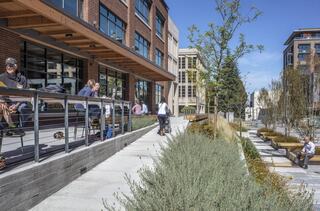Addressing the climate crisis with embodied carbon benchmarking
In 2022, we at SERA completed our second annual assessment of the embodied carbon emissions for our full portfolio of projects. We’re pretty excited about this. Why are we so passionate about such a technical undertaking? It’s only partly because we’re data geeks. Tracking carbon and avoiding materials and assemblies with large carbon footprints help us move towards our goal of working on projects that have a significantly reduced negative climate impact. As climate change consequences become increasingly severe, disproportionately affecting disadvantaged communities, gathering information and working to counteract those negative impacts is more important than ever. Though there are good benchmarking tools, resources, and strategies for tracking operational carbon emissions, embodied carbon emissions is an area that needs more research.
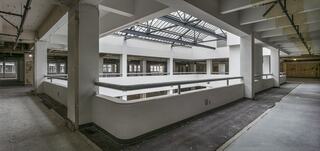
Low embodied carbon strategy: adaptive reuse of existing buildings—this is the Galleria's skylight before renovation.
Because large amounts of greenhouse gasses are emitted over a relatively short time—during the construction process—the immediacy and quantity of embodied impacts are even more significant than those related to operational carbon. Climate scientists have pointed out that addressing the short-term is crucial to minimizing the most destructive impacts of climate change. And as we learned with energy use reporting, knowledge is a prerequisite to making meaningful improvements.
Although an increasing number of design firms have begun studying the embodied carbon of their work, industry-wide benchmarking data is very limited. Our own growing data set at SERA is serving as a preliminary internal framework, and we are collaborating with the Carbon Leadership Forum, and other firms to support industry-wide benchmarking.
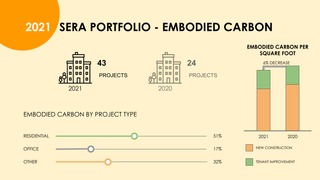
Compared to 2020, the total square footage in SERA’s 2021 portfolio was higher, and the embodied carbon emissions per square foot were lower. The total square feet of our new construction work increased by 110%, and the square footage of adaptive reuse/tenant improvements (TIs) increased by 30%. Although there was a large increase in the square footage of our portfolio, the embodied carbon intensity per square foot decreased by 6%. This decrease is a result of SERA’s efforts to specify low-carbon concrete, plant-based materials (when possible), and sustainably harvested wood (when working on timber projects).
Because consistency is valuable to make results between projects as comparable as possible, it’s important to be clear about our assumptions.
- We use industry-standard whole building life cycle assessment (WBLCA), referencing LEED and other certifications/standards when possible to better inform our analyses as time goes on.
- We assume a 60-year analysis timespan for new construction because this fully captures the scope of all the super/substructure and enclosure elements. In contrast to new construction, we have taken a stance to look at our TIs and adaptive reuse projects with a 5-year analysis timespan. This captures one instance of each material which is the scope of the project.
- We assume that a new LCA will be run for the next TI or adaptive reuse effort on the project, so we are only looking at the true scope of the project, avoiding double counting embodied carbon emissions in the future. Additionally, this avoids any inflation of materials because of assumed short refresh cycles.
Furthermore, SERA sometimes finds it difficult to set the boundaries of the analysis of an adaptive reuse project. Often, parts of the core and shell may be renovated as part of the scope, which makes determining the analysis timespan difficult. This difficulty is further complicated by the need to do our due diligence and account for the embodied carbon that may not have already been quantified in existing buildings. Moving forward, we will assume that the embodied carbon of a newly constructed project was accounted for or measured in some way, but for all existing buildings, designers should begin quantifying the embodied carbon impacts.

Low embodied carbon strategy: wood sourced from sustainably harvested forests
Now that SERA has collected two years of data, our methodology has started evolving as we attempt to make a meaningful apples-to-apples comparison between our projects. To smooth the variability of size, we are looking at the projects’ embodied carbon per square foot. We have also adjusted the life cycle assessment (LCA) scope to include the same stages for both new construction, TIs, and adaptive reuse. We do not include Module D, the phase for end-of-life benefits like reuse, recycling, and recovery, to avoid any potential for under-estimation of the embodied carbon impact. Additionally, we have adjusted the project scope to include all the same building elements. All projects, whether they are new or reused, include super/substructure (if any), enclosure (if any), interiors, and furniture. Consistent with current standard LCA practices, SERA does not include embodied carbon emissions for lighting, mechanical/electrical/plumbing equipment, or site due to a lack of data. We look forward to including these in the next year or two as better information becomes available.
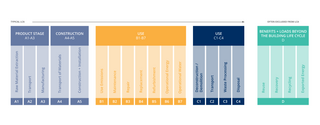
After looking at all the projects in our portfolio, SERA has learned that the phase during which projects are analyzed typically impacts the results. In early phases, such as concept and schematic design, fewer specific materials (especially interior finishes) have been selected, which can cause an unintentional underestimation of the final embodied carbon footprint. The other detailed decisions about interior finishes, furnishings, and walls can account for a significant percentage of embodied carbon emissions. SERA is currently working on tracking this underestimation to add a contingency factor in these early phases to more accurately estimate and track the embodied carbon of future projects.
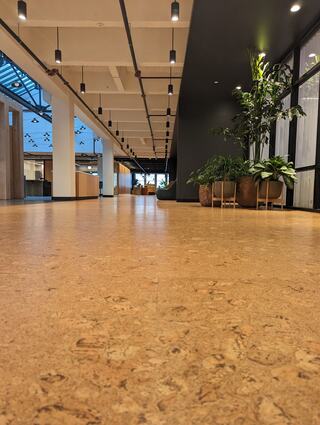
Low embodied carbon strategy: plant-based materials that sequester carbon, such as cork flooring
Additionally, SERA also noticed an enormous impact that the refresh cycle and replacement of materials can have on WBLCA results. For example, when looking at a building over 60 years the paint may be updated several times over the building’s lifespan. So while one application of paint has very low embodied carbon emissions, applying paint multiple times over a large surface area can create an embodied carbon hotspot, even compared to other high embodied carbon materials like carpet and gypsum wallboard.
SERA is eager to continue advancing embodied carbon benchmarking within our firm, and in collaboration with CLF and other firms, across the industry. As design firms, we have an important role to play in shifting construction toward practices that minimize and begin to reverse negative climate impacts.
Co-authored by: Beth Lavelle, Lindsey Naganuma, and Mark Perepelitza
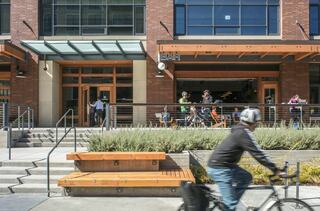
The Leland James Building is a beautiful transformation of what used to be a forbidding data center.
